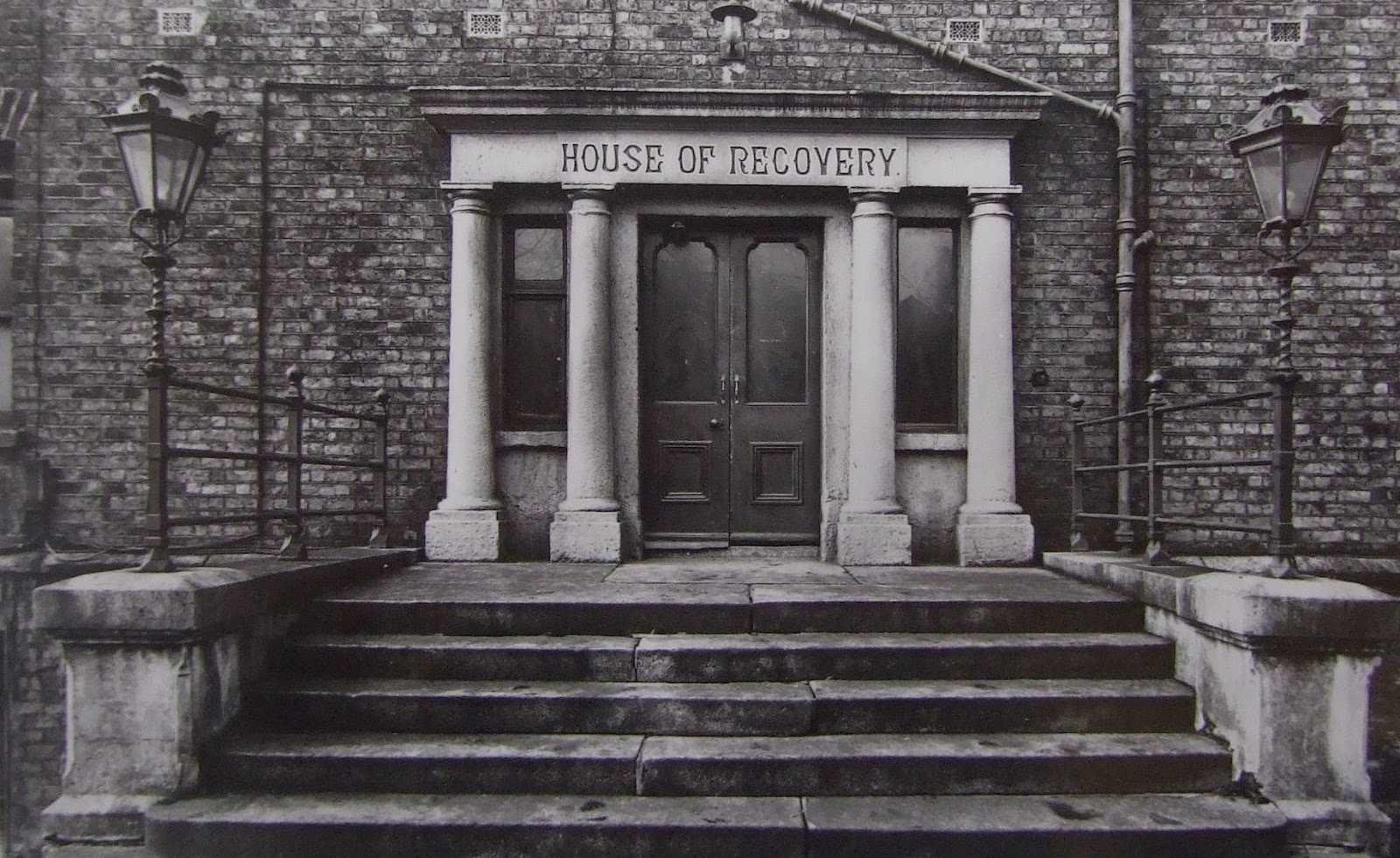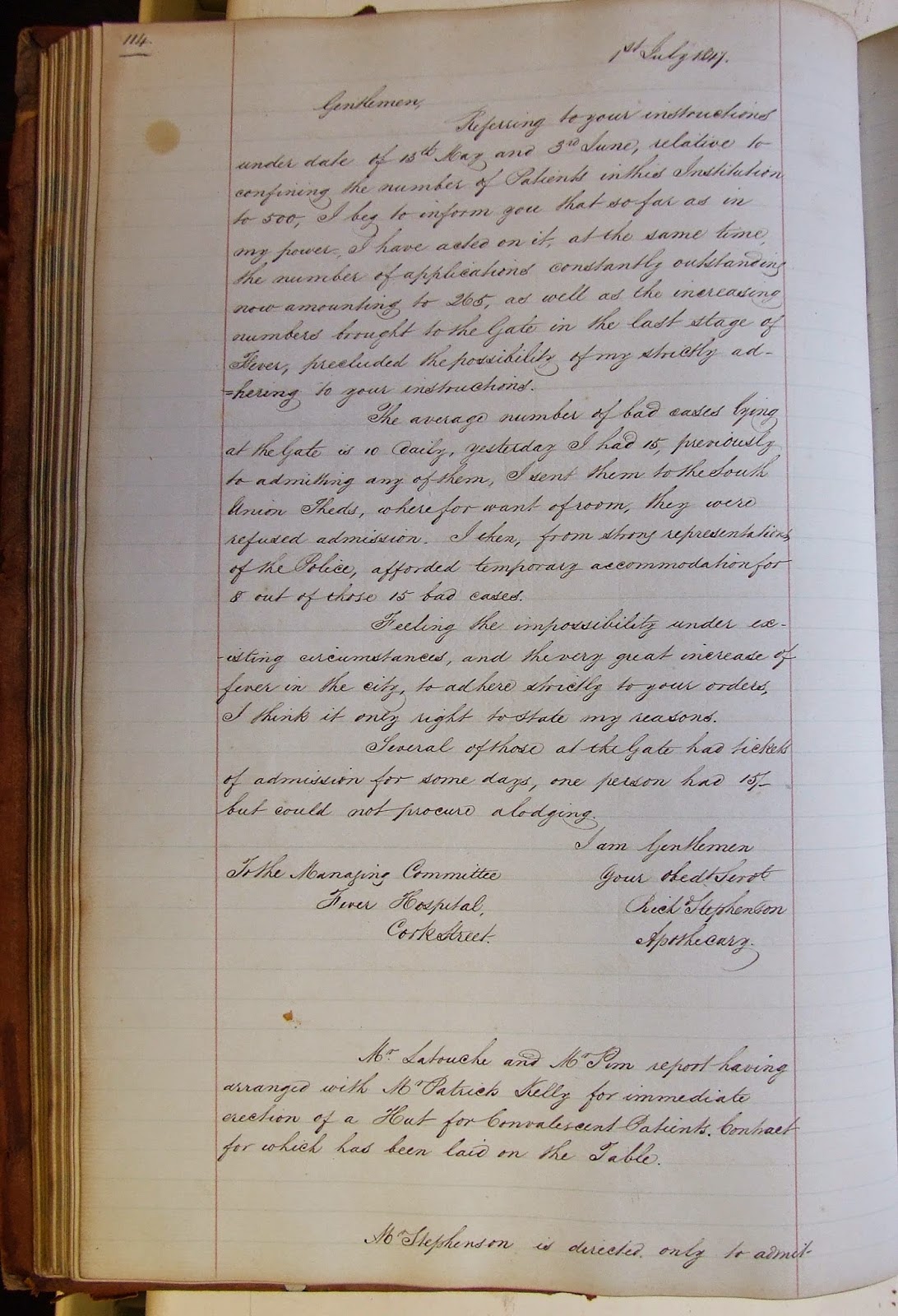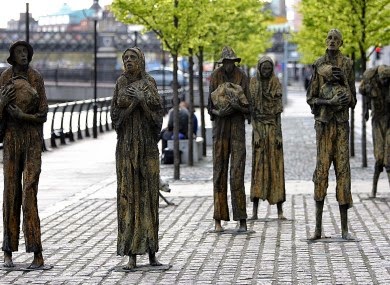'The numbers flocking into Dublin bring much contagion of a most dangerous character with them': Cork Street Fever Hospital and the Great Famine
Successive
failures of the potato crop led to more 1 million deaths in Ireland between
1845 and 1849. The majority of these
deaths have been attributed to infectious diseases. In Dublin, an influx of
refugees from the countryside during these years resulted in increased
vagrancy, overcrowding and neglect of personal and domestic hygiene, creating
optimum conditions for the spread of fever.
 |
| Picture of one of the wards in Cork Street Fever Hospital reprinted in a number of annual reports (CSFH/1/2/1) |
Admissions and Accommodation
In the late
1840s hospitals in Dublin came under severe pressure to cope with soaring
demands for admissions, particularly during epidemics of typhus in 1847 and of
cholera in 1849. Cork Street Fever Hospital in the Dublin Liberties was one
such hospital. In early 1847 the deepening crisis began be reflected in minutes
of meetings of its Managing Committee. On 27 May 1847 it was noted that:
‘As
it appears that several Patients are lying on the floor:
Ordered that fifty stretchers be forthwith provided, twenty-five
of three feet wide, twenty-five of two feet six inches’.
The need to
accommodate more patients exercised the Managing Committee greatly during these
years. In May 1847, James W. Cusack and David C. Latouche, members of the
Managing Committee, sent a letter to Thomas N. Redington, Dublin Castle, in
which they expressed their fear that:
‘The numbers that are every day flocking into Dublin to embark for
America bring much contagion of a most dangerous character with them, and we
have every reason to apprehend the most serious consequences to the health of
the town’.
 |
| Original Entrance to Cork Street Fever Hospital (CSFH/7/1/6) |
Cusack and
Latouche asked for funds to enable the erection of temporary huts to meet increasing
need to admit more patients, a request that received sanction from the Lord
Lieutenant. In late 1847 a number of tents and four wooden sheds providing
accommodation for an extra 480 patients were erected on the Cork Street
grounds.
The table
below shows that even this extra accommodation did not meet demand as the
situation worsened in late 1847, and applications for admission consistently
outstripped available space in the hospital.
Month
|
Applications for Admission
|
Admissions
|
Rejected Applications for Admissions
|
October
1845
|
330
|
254
|
76
|
November
1845
|
302
|
229
|
73
|
December
1845
|
345
|
256
|
89
|
January
1846
|
458
|
303
|
155
|
February
1846
|
379
|
275
|
104
|
March
1846
|
358
|
285
|
73
|
April
1846
|
416
|
310
|
106
|
May 1846
|
446
|
294
|
152
|
June
1846
|
368
|
251
|
117
|
July
1846
|
370
|
292
|
78
|
August
1846
|
355
|
262
|
93
|
September
1846
|
432
|
341
|
91
|
October
1846
|
560
|
380
|
180
|
November
1846
|
510
|
359
|
151
|
December
1846
|
625
|
393
|
232
|
January
1847
|
656
|
411
|
245
|
February
1847
|
744
|
558
|
186
|
March
1847
|
943
|
704
|
239
|
April
1847
|
1105
|
670
|
435
|
May 1847
|
1419
|
703
|
716
|
June
1847
|
1939
|
951
|
988
|
July
1847
|
1492
|
790
|
702
|
August
1847
|
555
|
405
|
150
|
September
1847
|
1365
|
656
|
709
|
The
distress faced by those rejected at the hospital gates was reflected in a
letter from the hospital Apothecary, Richard Stephenson, to the Managing
Committee on 1 July 1847. Stephenson stated that:
‘The average number of bad cases lying at the Gate is 10 daily.
Yesterday I had 15. Previously to admitting any of them, I sent them to South
Dublin Union Sheds, where for want of room, they were refused admission. I
then, from strong representations of the Police, afforded temporary accommodation
for 8 out of 15 of those cases’.[3]
 |
Letter of 1 July 1847 from Richard Stephenson to the
Managing Committee, reproduced in a minute book
(CSFH/1/1/9)
|
The Managing
Committee responded blankly by stating:
‘Mr. Stephenson is directed only to admit a number equal to one
half the number of persons discharged until the number of patients in the
Hospital shall be reduced to 500’.
Financial Pressure
Although
the response of the Managing Committee to Stephenson seems callous by today’s
standards, it was the product of severe overstretching of resources. As a
voluntary hospital, Cork Street depended on subscriptions from philanthropists
and Government grants to sustain its operations. As early as March 1847, the
Managing Committee were expressing fears to the Lord Lieutenant in Dublin
Castle that:
‘...the pressure on the Hospital has become so great within the
last two months and appears to be so rapidly increasing, that we fear even that
Estimate will be very much below the actual Expenditure’.
Additional
financial aid from Dublin Castle was not forthcoming, however. A letter from
Thomas N Redington, Dublin Castle, to James Montgomery, Register of Cork Street
Fever Hospital, informed him that:
‘the Grant for the Cork Street Fever Hospital will be proposed for
£3,800, being the same amount as for several years previous to 1843’.
The
gravity of the developing crisis does not appear to have been recognised by
Dublin Castle at this stage, as Redington’s letter continued by stating that:
‘the Lordships do not consider it advisable to increase the vote
to be proposed in aid of the funds of the Hospital to meet the expenditure
arising from a temporary pressure of this nature’.
 |
| Famine memorial in Dublin City Centre |
In fact as
the Famine progressed Cork Street Fever Hospital, in common with all Dublin
medical charities, received cuts rather than increases to its funding. In 1848 a ten percent
reduction in funding was imposed, and in 1850 the Government announced its
intention of completely withdrawing the grant from all Dublin medical
charities, a proposal which caused a great deal of outrage at meetings of the
Cork Street Managing Committee.
Government policy of gradually reducing the grant was only abandoned in 1851,
by which time the most virulent period of the Famine had passed.
Fergus Brady,
Project Archivist